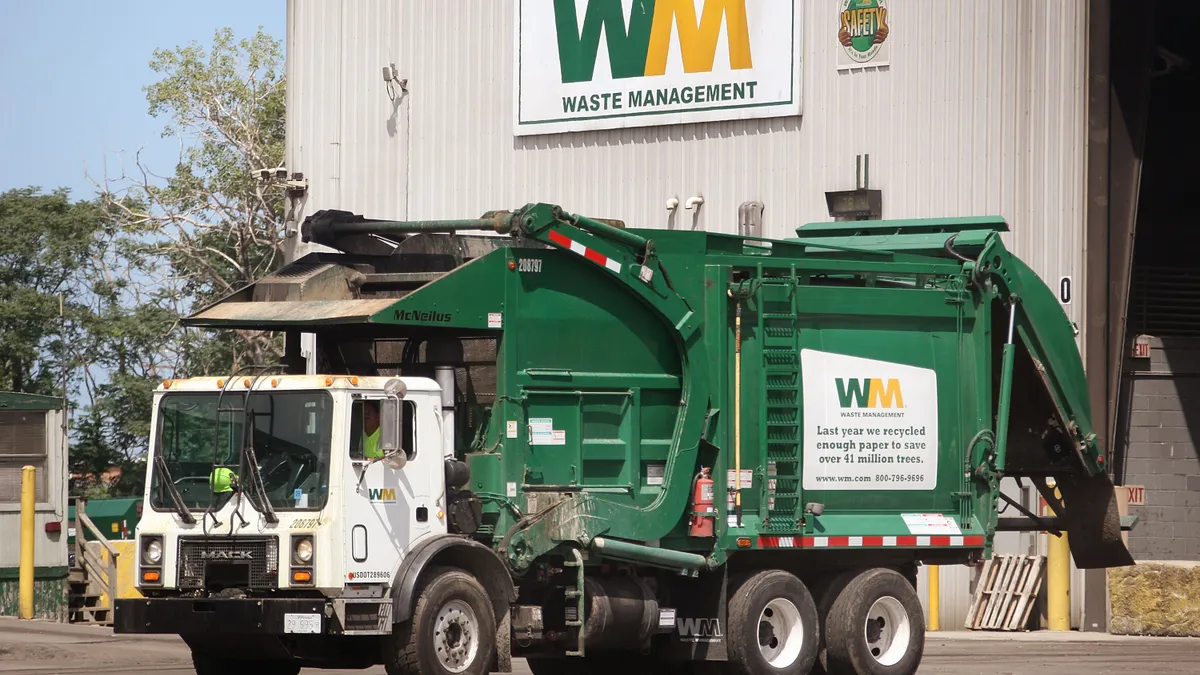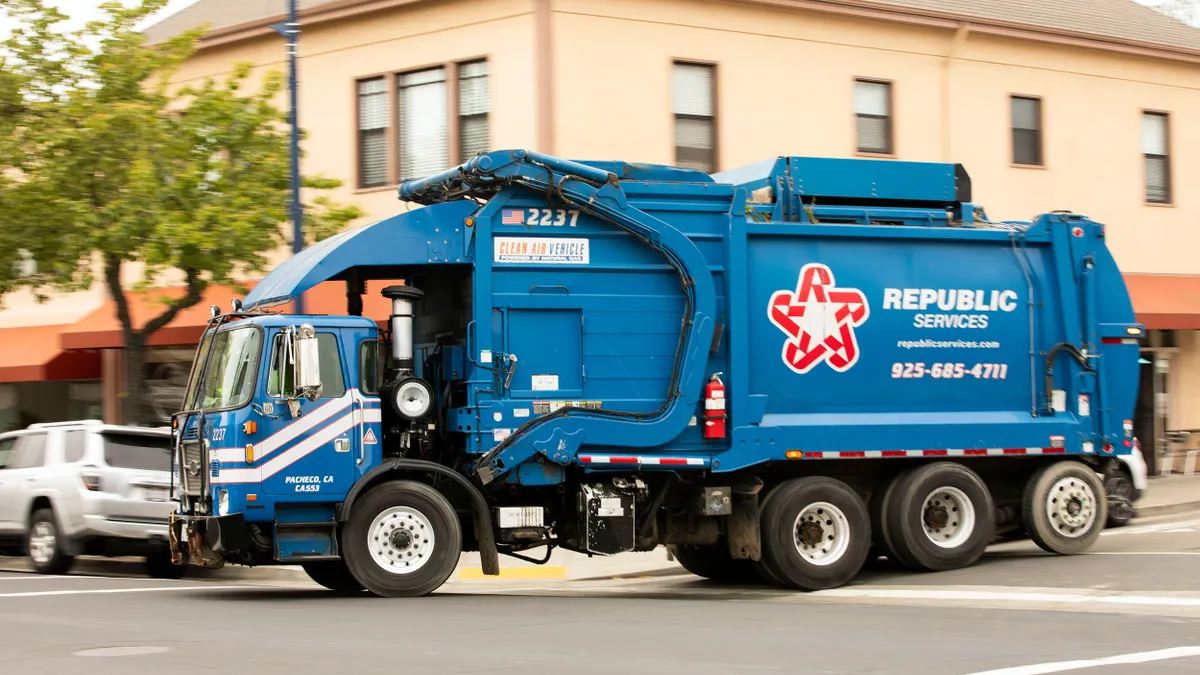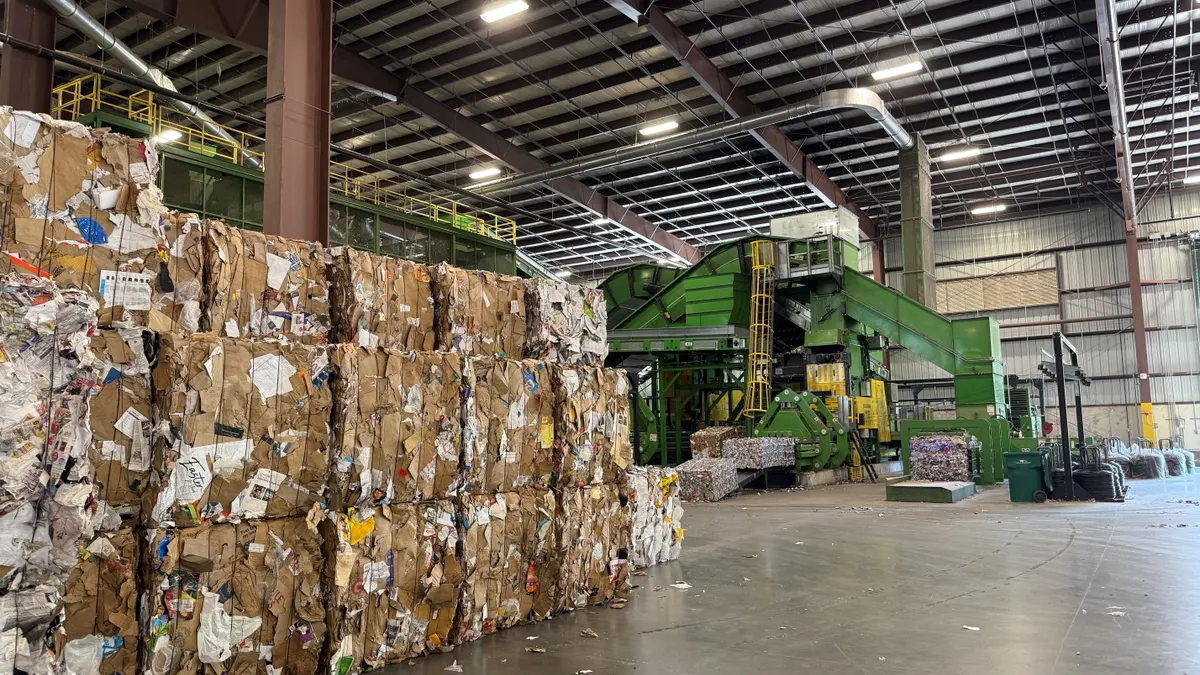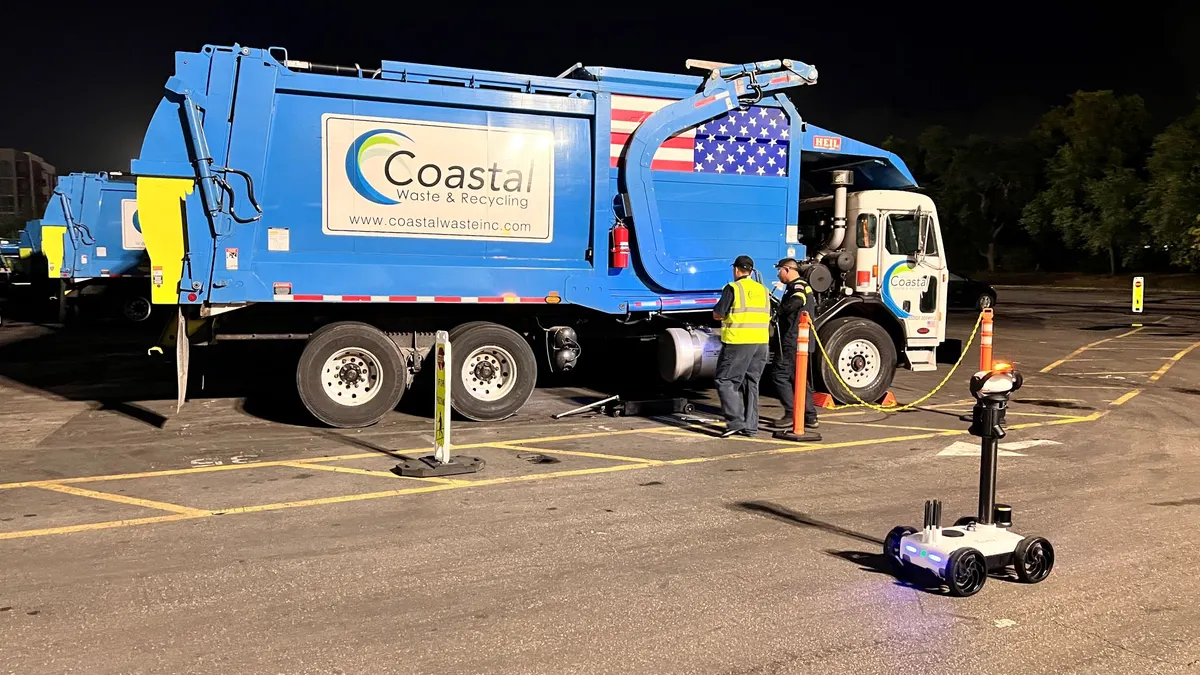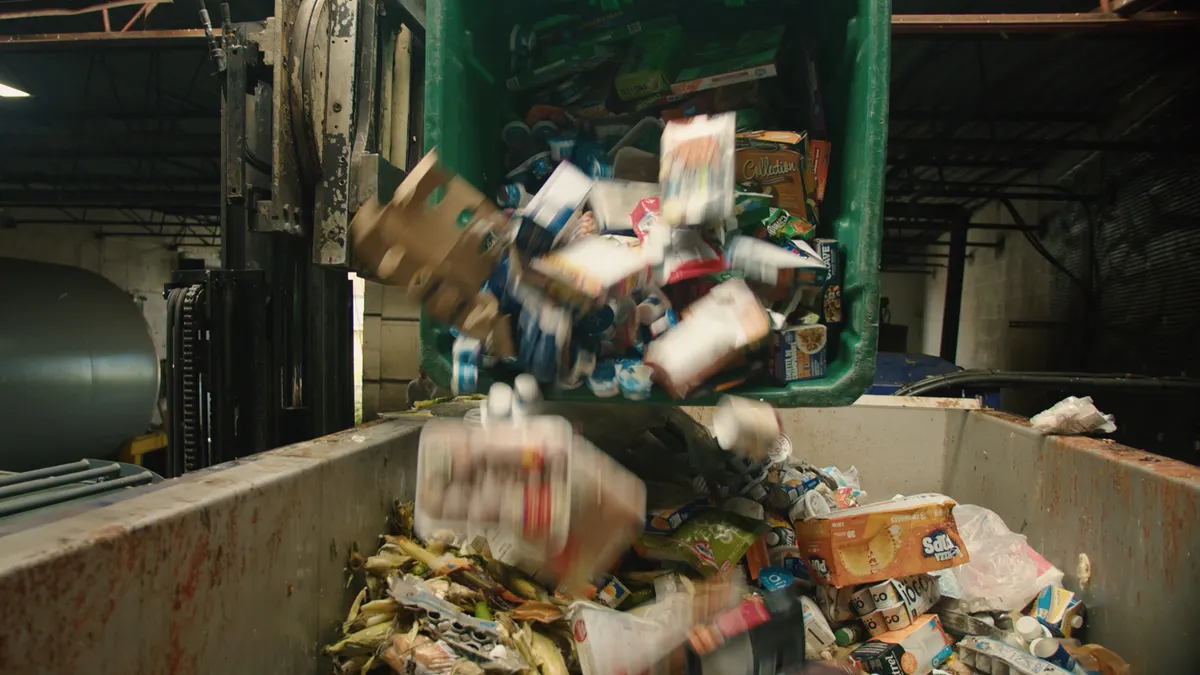Even after decades of public service announcements, many people still don’t truly understand recycling. Sure, they know they should do it, but the matter of why — or, more importantly, how — is lost on the average consumer.
The inherent conflict of more cities introducing new single-stream programs to reach big diversion rate goals while also trying to limit contamination has forced many to get creative with education. Officials around the country have started to see results by going door-to-door, digging through carts and occasionally sitting down for long talks. And while circumstances may differ, most officials agree that the key to any good recycling program is making it personal.
"Contamination is costing the system money and it’s endangering the health and safety of the workers," Jason Hale, vice president of communications for The Recycling Partnership, told Waste Dive. "It’s absolutely fixable, it’s absolutely curable, if you take the right approach."
Last year, the national nonprofit began working with the Massachusetts Department of Environmental Protection on new ways to address this in four municipalities. In the largest city, Lowell, a switch to single-stream in 2014 had led to new contamination issues. Working with city officials and the local material recovery facility (MRF) operated by Waste Management, The Recycling Partnership team figured out what items were most problematic and where they were coming from.
"Contamination is costing the system money and it’s endangering the health and safety of the workers."

Jason Hale
VP of Communications, The Recycling Partnership
They decided to focus on a select group of 500 middle-performing, multi-family households — within a system of 5,000 – and address the issue of plastic bags specifically. This entailed targeted mailers, magnets, cart tags, local ads and other tactics described in a recent webinar hosted by the Solid Waste Association of North America. A key move was to leave behind any bins that contained too much contamination and put a tag on them explaining why.
Over the course of eight biweekly collection cycles, the average rejection rate dropped dramatically while the set-out rate remained about the same showing that people didn’t become discouraged by the process. After the multi-month pilot was complete, data from Lowell and the city of West Springfield were combined to account for any inconsistencies. Analysis of carts by DSM Environmental Services found that the average amount of contamination by weight had dropped from 37% to 26%. The drop for plastic bags was even larger, from 43% to 15%. Citing textiles as an example, Hale said during the webinar the key to this success was that they didn’t make the messaging complicated.
Down in Tennessee, local officials in Memphis had been experiencing similar problems since they began a citywide switch to single-stream, with assistance from the Recycling Partnership and the Closed Loop Fund, which is still being rolled out.
Joy Williams, the city’s recycling coordinator, said that the switch to larger single-stream carts raised contamination rates from less than 2% to as high as 16%. Large amounts of textiles, hoses, computer cords and other items were even causing the local MRF to reject some loads. After talking to Hale about the Massachusetts projects she decided to try going house-to-house — albeit with some skepticism.
Williams and a team of city employees went out for random cart checks in an area that had been the source of rejected loads and used a similar tactic of leaving behind contaminated carts with tags. The city also followed up with large, full-color postcards to reinforce their message.
Within less than two weeks, Williams said that area stopped generating rejected loads and the city’s overall contamination rate has since decreased to about 12%. She is now a supporter of this concept because of its effectiveness in improving material streams and connecting with residents.
"In the old days people recycled for one reason, because somebody else asked them too," said Williams. "I see this as going back to a slightly personal touch."
Is single-stream the problem?
Pennsylvania’s Centre County Recycling & Refuse Authority also leaves unsuitable waste behind, but through a very different method than Memphis.
The authority collects from about 28,000 households, largely centered around the municipality of State College, and all of their recyclables are sorted right at the curb. A truck pulls a trailer with receptacles for eight different categories that collection workers can fill up in about 60 seconds per household. Whatever doesn’t fit their guidelines is left behind for homeowners and all of their neighbors to see.
While they recently considered making the switch to single-stream, county officials decided against it and have since become skeptical of the system’s widespread adoption. Executive director Ted Onufrak said this would only shift his labor costs to the MRF.
“You're spending all your time separating in the building,” he said. “There’s no fear of being caught in single-stream so people are going to abuse it. That’s human nature."
Both Onufrak and Joanne Shafer, the authority’s deputy director, were quick to note that their experiences aren’t directly comparable to what may work in other municipalities. They already have an estimated 90% participation rate, plus would need to spend a significant amount of money to upgrade their MRF and their fleet to accommodate single-stream. Neither say they’re surprised to hear that contamination rates have been rising amid the shift to single-stream and plan to share their thoughts at conferences this spring.
Shafer said part of the contamination issue has to do with a lack of understanding about the role that recycled materials play in manufacturing. When giving facility tours to students she said this is the biggest point she tries to make, more so than recycling’s environmental benefits.
“When you look at [it] in that regard then the contamination issue becomes clear,” said Shafer.
Studying recycling motivation
Cracking consumers' recycling behavior has long been a priority for any hauler or municipality. While cart tagging may be effective, some don’t see it as getting to the root of the issue. Countless studies have been conducted, but no one really knows whether people are driven by a desire to support the manufacturing process, environmental awareness, peer pressure, or something else entirely.
In Texas, the city of Austin is in the midst of a multi-month study to figure out why its diversion rate has stalled in the low 40% range and learn more about its residents in the process. Contamination has also been a factor in the city’s single-stream system, with plastic film products, wire hangers, hoses and textiles cited as the most common issues.
Austin Resource Recovery (ARR) is only responsible for collecting from single-family households and buildings with up to four units, but in a project with the city’s Design, Technology and Innovation Fellows they decided to talk to residents in any type of building. Over the course of four weeks last year, a team of researchers met with more than 50 Austin residents for 90-minute interviews to figure out how recycling fit into their lives.
"A lot of cities, including our own, have a lot of quantitative data — the 'what' is happening but not the 'why,'" said Katherine Duong, a fellows research design specialist.
These in-depth conversations helped the research fellows gauge people’s ability, knowledge and motivation around recycling. Some people were “zero waste” diehards that recycled everything. Others said they didn’t have the time, weren’t sold on the importance of taking up space for a separate bin in their kitchens, or just didn’t understand the rules.
"Some people will still place things into the recycling bin just because they think they’ll get sorted out on the back end,” said Ron Neumond, a fellows research analyst and ARR liaison. “Whenever people are forced to make a decision they’re kind of making up their own rules.”
Using all of this insight, the team developed a report with initial findings that broke down interview subjects into five different categories of recyclers who can now be targeted with prototype solutions. For example, "The Analyst" doesn’t understand why their contribution to the recycling system matters and may benefit from a targeted educational mailer with facts on the city’s program. Or "The Well-intentioned" recycler may need an update on the regulations around what they should be putting in their carts.
"Whenever people are forced to make a decision they’re kind of making up their own rules."

Ron Neumond
Research Analyst
The team of fellows will continue working with ARR to roll out specific solution into the early spring, but Duong already sees at least one key lesson that other municipalities could emulate.
"Instead of doing what you have always been doing," she said, "really go deeper into people’s motivations and knowledge levels.”
Finding a solution — and sticking to it
Cities may never truly figure out why residents decide to recycle certain materials. Packaging materials change, lists of accepted items can shift with commodity prices and residents often move between locations with entirely different regulations.
Based on working with The Recycling Partnership, the Massachusetts DEP has released a free “Recycling IQ Kit” that municipalities can customize for their own needs and similar pilots can be expected in other states this year. Hale sees specificity as the key to their success so far.
"Nobody is going to be a perfect recycler so just getting them to be a good enough recycler should be the first goal. Focus on your worst thing and you can tackle it," he said.
This hyper-targeted approach is a common theme across all of these programs and one that has caught the eye of those in the technology field as well.
Data analytics company Zerocycle is now working with five municipalities to provide neighborhood-specific reports that let residents compare their recycling performances. Founder & CEO Hunter Hayes told Waste Dive that he sees targeted contamination education as a logical next step.
"Cities are vibrant places and they have different constituents across the city so you have to be able to speak to them in more than one way," he said.
Using datasets from MRFs and municipalities, Hayes said it would not be difficult to trace contamination back to its source without even having to dig through carts at the curb. He said the key is to make people care first, whether the method is rejecting contaminated carts or instilling a sense of peer pressure by comparing neighborhood statistics.
"The fatal flaw has been the assumption that the more education people have, the more they understand about the way things are running, the more they’re going to care," he said. "I think you have to make them care about it and then give them access to the information so they can do better."
"The fatal flaw has been the assumption that the more education people have, the more they understand about the way things are running, the more they’re going to care."

Hunter Hayes
CEO, Zerocycle
For local programs that are trying to hit big "zero waste" goals, adapt to a new collection method or find a cleaner stream of material to make more money at the local MRF, it’s clear that old methods could use an update. Municipalities will need to decide what works best for them and then find a clear way to make that decision known to all residents.
“You have to educate everybody all the time. You can’t do it once and think that it’s done,” said Centre County’s Shafer. “When you think you’ve done it, do it again."







